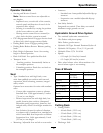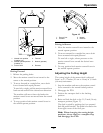
Operation
2. Apply forward pressure to the upper hoop of the
roll bar.
3. Pull the knob and rotate 90° to hold in the
unlatched position to lower the roll bar.
4. To return to the operate position, raise the roll
bar, and then rotate knobs 90° so that the tabs
interlock partially. Apply forward pressure to the
roll bar upper hoop and observe that the knobs
return to the completely latched position.
Figure 13
1. Roll bar upper hoop
2. Knob in “latched” position
3. Pull knob to unlatch
4. Rotate 90° to hold unlatched
5. Knob in “unlatched” position
5. Make sure the knobs are fully engaged with the
roll bar in the raised position. The upper hoop of
the roll bar may need to be pushed forward or
pulled rearward to get both knobs fully engaged
(see Figure 14).
Figure 14
1. Engaged 2. Partially engaged — Do
Not operate with ROPS
in this condition.
Important: Always use the seat belt with the
roll bar in the operate (raised) position. Ensure
that the rear part of the seat is secured with the
seat latch.
Open the Fuel Shut-Off Valve
The fuel shut off valve is located behind and below
the seat. Rotate the valve and align with the fuel line
to open.
Starting the Engine
1. Move the motion control levers out to the neutral
lock position.
2. Pull up and back on the parking brake lever to
engage the parking brake.
3. Push down on the PTO switch to the “disengage”
position.
Note: It is not necessary for the operator to be
in the seat to start the engine.
4. Place the throttle midway between the “SLOW”
and “FAST” positions.
5. On a cold engine, push the choke lever forward
into the “ON” position.
On a warm engine, leave the choke in the “OFF”
position.
6. Turn ignition switch to the “START” position.
Release the switch as soon as the engine starts.
Important: Do Not crank the engine
continuously for more than ten seconds at a
time. If the engine does not start, allow a 60
second cool-down period between starting
23


















